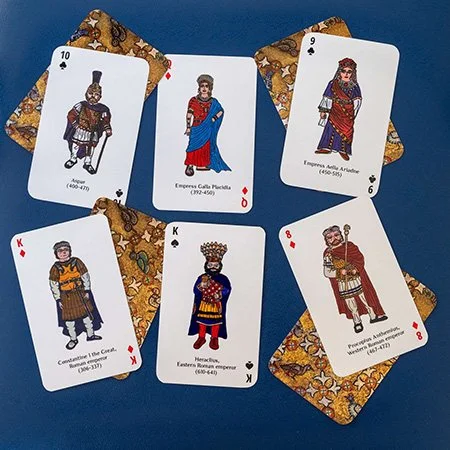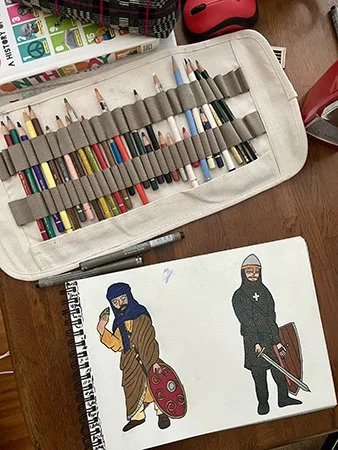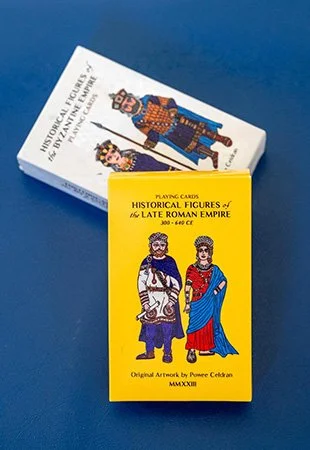Passion for the Byzantine

Powee beside an imperial tomb in Instanbul. (Photo by David Celdran)
Through his website, blog, Instagram, and Facebook accounts Celdran also shares timelines of wars, important events, Byzantine guides to countries, and other interesting historical tidbits highlighting Byzantine history. In 2023, he collaborated with an international group of artists and writers from Greece and Italy to create the board game, “Battle for Byzantium.” He also made two editions of playing cards–Historical Figures of the Byzantine Period and Historical Figures of the Late Roman Period, featuring weapons, jewelry, and the various personalities of the Byzantium. Last year, he came out with Byzantine postcards and a poster. His book focusing on 62 important years in Byzantine history will be published by Gentry Press in the Philippines.

Historical Figures of the Byzantine Empire playing cards designed by Powee Celdran. The backside was inspired by the ceiling of the Archbishop’s Chapel in Ravenna, Italy. (Photo by David Celdran)
Seeing the Byzantium through Celdran’s eyes, makes ancient events relatable. For example, lucky owners of the limited edition board game (only 100 pieces were made and sold) get to compete as rival warriors as they acquire Byzantine cities. Set in 1025 AD after the death of Emperor Basil II, fictional Normans, Arabs, Varangian (Viking guards of the Byzantine empire), and Byzantine commanders vie for control. They advance/retreat depending on the action cards picked. For example, players move forward if they sack a city, and move back if they get hit by “Greek fire,” a Byzantine weapon made of flammable liquid that burns in water. Along the way, players learn about the history and culture of the 18 cities included in the game. The ultimate prize in the game is the ancient city of Constantinople (now Istanbul), the center and foundation of the Byzantine Empire that spanned “eastern Mediterranean, Balkans, and Western Europe.”

The ceiling of the Archbishop’s Chapel in Ravenna, Italy, Details from the ceiling inspired the backside of the playing cards Powee designed. (Photo by David Celdran)
Celdran’s passion for this historical period was sparked by the book Byzantium: The Surprising Life of a Medieval Empire, written by Judith Herrin, who was a professor of Byzantine and Medieval history at Princeton and King’s College London. Herrin shared the highlights of an empire while avoiding the more sensational stories that can rival any high-budget historical drama replete with “plots, assassinations and physical mutilation, coupled with excessive wealth, glittering gold and jewels.” Perhaps for the Byzantine novice, it is important to know that if not for the Byzantine empire, “there would have been no Europe,” according to Herrin.
For Celdran, the seemingly distant history of the Byzantine empire is relevant to Filipinos in two ways. Philippine law and the Roman Catholic faith can trace their roots back to the Byzantine era. Byzantine law that followed the Roman legal system was further organized and codified, removing contradictions and conflicts. This started with the Codex Theodosianus. Legal experts were tasked to compile, edit, and reform all the imperial laws in one book that was later distributed throughout the empire and taught in law schools. A century later, Emperor Justinian ordered a review and had the laws adjusted to life in the 6th century; that became the Codex Constitutionum. A summary of this Corpus Iuris Civilis, also known as Corpus of Civil Law, is the basis of European law. The Philippines, as a colony of Spain, adopted its legal system based on civil law. A combination of civil law, common law, and Islamic law is presently used in the Philippines.
Though the Byzantine empire is Orthodox Christian, Celdran points out that the Catholic faith can trace many of its doctrines from the ecumenical councils held by early Byzantine emperors such as Constantine the Great and Theodosius the Great. The Nicene Creed, a profession of faith that is still prayed by Roman Catholics at mass today is a product of one of the ecumenical councils.
Celdran could not resist mentioning inventions that the Byzantine empire gave to the world. One such item is the fork introduced in Venice by Maria Agryropoulaina. It was a luxury item at first before spreading in popularity in Europe. Herrin thinks of the “small two-pronged gold fork” as a symbol of Byzantine cultural influence in the world.
Inspired by the history-themed playing cards he bought as souvenirs Celdran designed his own deck of playing cards. Each card is unique and features his favorite characters and artifacts from the Byzantium. On his webpage, one can find a detailed description, some several pages long, of each character in the second set of cards called “Late Roman.” The backside of his cards show lovely golden mosaic patterns on a blue background, inspired by a visit to the Archbishop's chapel in Ravenna, Italy where he captured the image from the ceiling. His interest in the non-Byzantine also shows in the first set of cards he made. One of the Joker cards is outfitted as a Byzantine-inspired Mandalorian, a shout out to Star Wars fans.

Historical Figures of the Late Roman Empire playing cards designed by Powee Celdran. The backside was inspired by the ceiling of the Archbishop’s Chapel in Ravenna, Italy. (Photo by David Celdran)
The cards’ illustrations were thoroughly researched and based on existing images from mosaics, coins, and paintings of historical characters, clothing, and objects. Creating the playing cards was a painstaking process as each figure is illustrated and colored by hand. Celdran first pencils an outline on a sketchpad, colors it with coloring pencils, and outlines the illustrations with an inking pen as the finishing touch. The only time he uses a digital tool is in editing the images for printing on a card format. This whole process takes two days.

An Entrepreneur graduate of MINT (Meridian International College), Celdran puts his business skills to good use by selling his products online and in local and international outlets. Around a thousand of his cards have been sold. In the Philippines, his cards are available at the Ayala Museum and Mt. Cloud bookstore in Baguio. Harvard-Dumbarton Oaks in Washington, DC restocked the cards three times while Homer Kitabevi bookstore in Istanbul also reordered more. His board game was sold through his IG account, Rustan’s, and independent local stores and is currently out of stock. It is his hope that a publisher will pick up his game. His ultimate dream is to have his products sold at the Metropolitan Museum and the British Museum, which have extensive Byzantine collections.

Playing Cards Box (Photo by David Celdran)
Celdran has traveled to many cities that were part of the Byzantine empire. His supportive parents, David and Jennie Celdran, have encouraged Powee’s passion. They were also influenced by him as their family travel itineraries now include Istanbul and other Byzantine cities, places they have also come to love. David, a broadcast journalist and history buff, says his son opened up a “vast reservoir of historical topics about Byzantine statecraft, art, food, and culture.”

Powee with Hagia Sophia in the background. The Hagia Sophia is c considered one of the best examples of Byzantine architecture. (Photo by David Celdran)
For Celdran, the seemingly distant history of the Byzantine empire is relevant to Filipinos in two ways. Philippine law and the Roman Catholic faith can trace their roots back to the Byzantine era.
Celdran studied in Oxford, taking a specialized course on Byzantine Constantinople as part of the Oxford Experience program at Christchurch College. The Greek Embassy of Washington, DC invited him to its 2023 online symposium, “Byzantium as a Source of Inspiration in the Modern World.” He was the lone Filipino among Byzantine scholars. One of the moderators, Chrissochos Vassiliosv, said he uses Celdran’s videos in his Byzantine Studies class at the St. Demetrios Preparatory School in New York and thought the board game would make a great teaching tool for his students.
Learn more about the Byzantium and Powee Celdran here: Website, Blog, Facebook, Instagram, YouTube

Titchie Carandang is a freelance writer. Her articles have been published in the White House Quarterly, Northern Virginia Magazine, Metro Style, Connection Newspapers and other publications. She is the co-founder and was co-director of the Philippines on the Potomac Project (POPDC), where she researched Philippine American history in Washington, D.C. She has received awards from the Philippine American Press Club, the Mama Sita Foundation, and the Doreen Gamboa Fernandez Food Writing Award for her writing.
More articles from Titchie Carandang



No comments: